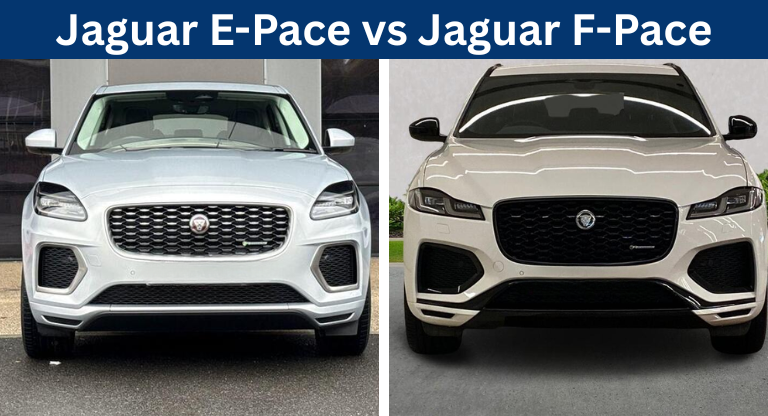- October 24,2025
Jaguar E-Pace vs F-Pace: Which Luxury SUV Wins?
The rivalry between the Jaguar E Pace and F Pace pits two stylish, luxury SUVs against each other. Both models are built around Jaguar’s Ingenium family of turbocharged engines and offer All Wheel Drive and refined interiors. For UK drivers searching for a compact or midsize SUV, the choice often boils down to personal priorities – agility versus space, economy versus performance. The heart of the vehicle (engine) also plays a vital role when we compare these two beasts. For those who are looking for the Jaguar E-Pace engine for sale in the UK market, it has the option of the four cylinder units that offer speed and use balanced fuel as compared to the F Pace engine. From 2015 onwards, Jaguar engines for sale and come with the Ingenium engine lineup for better tech advancement and smooth operations. On the other hand, those who are seeking the Jaguar F Pace, a four-cylinder and six cylinder engine variant option available for a faster response, but it consumes more fuel. In this guide, we are going to compare Jaguar’s two vehicles, including the engines, reliability, maintenance and longevity, so you can decide which vehicle will suit you.
Background and Engine History
Jaguar launched the F Pace in 2016 as its first performance orientated SUV. It employed the new in house Ingenium engine family, which uses modular turbocharged four cylinder and six cylinder units with aluminium blocks and direct injection. Over time, Jaguar added mild hybrid systems and, in the F Pace SVR, a supercharged V8 to broaden its appeal. The smaller E Pace arrived in 2017 to target the booming compact SUV market. It uses variations of the 2.0 litre Ingenium engine and later incorporated mild hybrid technology to improve fuel economy and reduce emissions.
Technical Specifications Comparison
For the UK market, both SUVs offer similar levels of technology and safety, yet their performance differs substantially. The table below summarises key engine specifications.
| Feature | Jaguar E-Pace (Compact SUV) | Jaguar F-Pace (Luxury Performance SUV) |
| Vehicle Size | Compact, shorter length (~4.4m) | Large, longer length (~4.75m) |
| Engine Range | 2.0L Petrol & Diesel (MHEV*) | 2.0L, 3.0L & 5.0L V8 engines |
| Plug-in Hybrid | P270e (269 PS) | P400e (404 PS) |
| Top Performance | P270e (0-60 mph in 6.8s) | SVR 575 (0-60 mph in 3.8s) |
| Boot Space | ~494 litres | ~485 – 613 litres (varies by engine) |
| Transmission | 9-speed Automatic | 8-speed Automatic |
*MHEV = Mild Hybrid Electric Vehicle
Strengths of Each Vehicle
The E Pace offers several advantages. The compact SUV’s fuel efficiency as one of its strengths; the mild hybrid system helps deliver respectable economy for city drivers. Its smooth and responsive performance and nine speed automatic transmission provide easy driving in urban or highway conditions. The E Pace also features advanced technology, including a regenerative braking system that recovers energy to assist during acceleration. Drivers seeking a luxurious yet manageable SUV will appreciate its easy manoeuvrability and high quality interior.
The F Pace, meanwhile, emphasises power and versatility. With three engine choices, buyers can prioritise efficiency (P250), balanced performance (P400), or outright speed (P550). The P250 engine offers an extra 30 lb ft of torque compared with the E Pace’s P250. The P400’s mild hybrid technology boosts mid-range acceleration without sacrificing too much fuel economy, while the SVR’s V8 delivers supercar like performance. Moreover, the F Pace’s larger dimensions provide more rear seat space and cargo capacity, making it a better fit for families or long trips.
Weaknesses and Reliability Concerns
No SUV is perfect. The E Pace’s main drawbacks stem from reliability and practicality. Potential buyers should be aware of noise levels during hard acceleration and a limited towing capacity that may not meet the needs of those who regularly haul trailers. Some E Pace owners experienced timing chain rattle from cold, DPF blockages leading to oil dilution, and gearbox issues that cause delays when selecting gears. It also notes failures in the electric tailgate struts and infotainment glitches. These issues highlight the importance of maintenance and thorough pre purchase inspections.
The F Pace shares some reliability concerns, though its six cylinder and V8 engines have their own issues. F Pace engine breakdown lists premature timing chain wear, turbocharger problems, and crankshaft failures in early 3.0 litre diesels. It also mentions water pump leaks on supercharged models and faulty driveshafts on some early 2016 vehicles. These problems underscore the need for regular servicing and extended warranties.
Driving Experience and Practicality
On the road, both SUVs deliver a blend of comfort and sportiness. The E Pace’s compact footprint makes it easy to park and manoeuvre in congested urban areas. Its suspension is tuned for a supple ride, while the steering is precise. The nine speed automatic sometimes hesitates at low speeds, yet the engine feels refined once up to speed.
The F Pace has a firmer ride and sportier handling, particularly with the optional adaptive dampers. Its chassis, shared with some performance saloons, provides sharper turn in and a more dynamic feel. The P400 and V8 engines also give the F Pace superior overtaking power and more effortless long distance driving. However, its larger size can make it less nimble in tight city streets.
Which SUV Should You Choose?
Deciding between the E Pace and F Pace depends on priorities. Choose the E Pace if you want a compact luxury SUV with stylish design, a comfortable interior and decent fuel economy. The single engine choice keeps running costs predictable, and it’s easier to park in urban settings. Choose the F Pace if you prefer more space, stronger performance or the option of a high powered mild hybrid or V8 engine. Families and driving enthusiasts will appreciate the F Pace’s versatility.
Frequently Asked Questions
What is the common fault with the Jaguar E Pace?
The most common fault is timing chain wear on the 2.0 litre Ingenium diesel. Oil degradation from incomplete DPF regenerations and long service intervals can cause the chain to stretch; if left unrepaired, it may snap and destroy the engine. Turbocharger issues, failing piston cooling jet solenoids and DPF/AdBlue problems are also reported.
How much does a new Jaguar engine cost?
A new Jaguar engine in the UK typically costs between £5,000 and £8,000+, depending on the model and type.
How much does a rebuild engine cost?
Rebuilding a Jaguar engine in the UK ranges from £1,500 to £4,000+ on average. Costs depend on the model, damage extent, and parts used.
Is it cheaper to rebuild or replace an engine?
Rebuilding is often cheaper than replacing if the engine block remains in good condition. However, severe damage might make replacement more cost-effective for longevity.
What is the best engine in the E-Pace?
The best engine in the Jaguar E-Pace is the D165 diesel for fuel efficiency and torque in long drives. The P250 2.0-litre petrol offers balanced performance at 246 horsepower. For hybrids, the P300e PHEV provides electric range and power. Choice depends on driving style; diesel suits economy, petrol for responsiveness.
Is the Jaguar E-Pace worth buying?
The Jaguar E-Pace is worth buying for its agile handling, stylish design, and updated interior tech like the 11.4-inch screen. It suits urban drivers with good safety features. However, consider reliability issues like electrical faults. With proper maintenance, it offers premium value, especially for used models.
How long does a Jaguar E Pace engine last?
A Jaguar E-Pace engine lasts 150,000 miles or more with regular maintenance like oil changes every 5,000-8,000 miles. Ingenium engines endure longer under highway use. Lifespan reaches 200,000+ miles with proper care.
Is the Jaguar 2.0 Ingenium engine reliable?
The Jaguar 2.0 Ingenium engine has mixed reliability. Petrol versions like the P250 are more dependable with rare VVT solenoid issues. Diesel models suffer timing chain failures and DPF problems, especially pre-2020. Updates improved them, but frequent servicing is key to avoiding breakdowns.
What is better Jaguar E Pace or F Pace?
The F-Pace is better for larger space, stronger engines, and family use with more cargo. The E-Pace excels in compact size and city agility.
Is it worth fixing a bad engine?
Fixing a bad Jaguar engine is worth it if repair costs are under half the car’s value and the body remains solid. For example, a £4,000 rebuild on a £20,000 vehicle makes sense.

